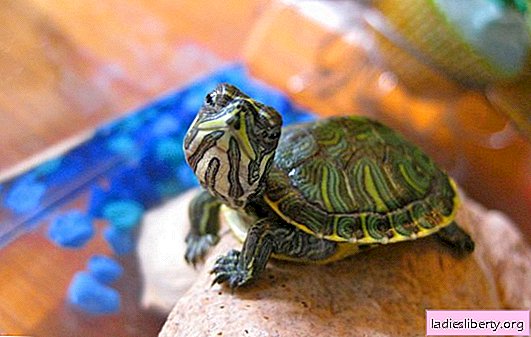
Before you get an exotic animal, you need to familiarize yourself with the recommendations for caring for him, as well as arrange living space.
In the natural environment, the average life expectancy is from 20 to 30 years. In captivity, with proper maintenance, they can live up to half a century. The age of the animal is determined by the number of rings on the shell. Two to three rings form in a year.
Before buying a turtle, study the features of care and get everything you need for a comfortable animal life. After the purchase, show it to the veterinarian who will examine the turtle for injuries or illnesses.
Advantages and disadvantages of keeping turtles at home
The benefits of keeping turtles at home:
• Unpretentiousness. Turtles require minimal care - creating living space and feeding.
• Hypoallergenic. The animal can be wound by those who suffer from allergies to coat.
• Economy. Turtles are not expensive and do not require additional vaccinations. The animal feeds mainly on plant foods or fish.
• Life expectancy. Pets live for 30 years, so the owner will not often be upset by the loss.
• Turtle is the safest pet. She will not bite and will not frighten an adult or a child.
Cons Cons:
• The complexity of the treatment. Not every veterinarian can cure a turtle, and not every city has professional herpetologists.
• If they are not kept properly, turtles often develop fungal diseases or have problems with the shell.
• Turtles like to move around at night, creating scratching sounds. This can be a real problem for people who sleep sensitively.
Living space arrangement
The animal should not walk freely around the rooms. To keep turtles at home, you need to organize a closed separate dwelling: an aquarium equipped according to all the rules or a terrarium.
Aquarium equipment necessary for all types of turtles:
• aquarium or terrarium;
• steady, convenient feeding trough;
• thermometer;
• Ultraviolet lamp;
• lamp;
• heater / lamp.
For the maintenance of land turtles will need to equip a house.
Additional equipment for aquatic species:
• filter (internal or external);
• water heater at 100 watts;
• shore / islet.
Aquatic turtles are in the water most of the time. It is necessary to organize a dry, warm place to relax and take ultraviolet baths. The island should be rough, without sharp corners.
The volume of the aquarium for aquatic turtles should be at least 200 liters. For land species, a capacity of 100 liters is needed.
Inside the aquarium there should be a house where the pet can hide and relax. It can be made from half of a ceramic flower pot by pre-processing the edges.
Hay is used as soil, which is easy to change. As a rule, two layers of coating are laid at the bottom: down - sand, on top - coarse pebbles. Soil for the maintenance of aquatic turtles is not used.
In the maintenance of aquatic species, the quality and temperature of the water play a crucial role. Twice a week it needs to be changed. Before this, water must be defended.
For land turtles, a heater is installed near the feeder. The optimum temperature for this species is 26 ° C. Water turtles are warming on the shore. The temperature on the shell should not exceed 30 C.
Feeding turtles
The diet of land turtles consists mainly of plant foods. These are vegetables, fruits, herbs and berries. You can also give various cereals.
Be sure to introduce calcium-rich foods into your diet: boiled eggs and raw minced meat. It is advisable to add calcium to the feed.
The diet of aquatic turtles is 70% from plant foods and 30% from animals. You can feed as a ready-made feed, or regular food.
Until the age of two, turtles are fed once a day. As they grow older, the amount of plant food increases. Adult animals are fed once every two to three days.
Aquatic turtles are fed in an aquarium.
Hygiene rules for keeping turtles at home
The walls and bottom of the aquarium are cleaned daily. The dishes for feeding and drinking are washed as they become soiled. Aquatic turtle housing is cleaned twice a month.
Every week, land turtles are bathed in warm water, after which the animal is wiped dry.
Periodically, in land turtles, you need to trim the claws and beak with special nippers.
Breeding turtles
In captivity, turtles mate year-round. With proper care, the female is able to lay up to four clutches of twenty eggs per season. For a pregnant turtle, you need to prepare a suitable nest.
Small turtles require special conditions of detention and are susceptible to various diseases. The first time after birth, babies eat through the yolk sac on the plastron. When it resolves, the turtles begin to eat in the usual way. It is important to observe the temperature regime: for water it is 27 ° C, for air - 32 ° C. The water is changed and filtered every two days.
Health tips for keeping turtles at home
The health of the pet largely depends on compliance with the rules for care, maintenance and feeding.
Guidelines for maintaining healthy turtles:
• maintain water balance by avoiding dehydration;
• for a sick animal, increase the temperature of the content to 30 ° C;
• if infection is suspected, the animal is isolated. After contact with the turtle, the hands are thoroughly washed;
• if the turtle is sick, reduce the water level so that the animal does not drown;
• Do not self-medicate. Contact a herpetologist veterinarian immediately.
A person chooses a pet for his temperament. Turtle is perfect for people who do not like fuss. A great option as the first animal for a child who will be happy to care for an unpretentious pet.











